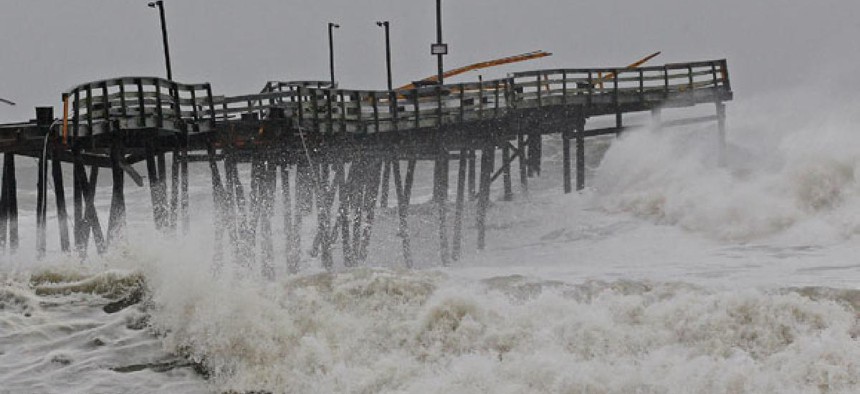#Sandy hits government

Waves crash in North Carolina as Sandy hits the East Coast. Gerry Broome/AP
Government updates on the social media storm front.
This story was last updated at 3:35 p.m.
Here’s a roundup of how federal agencies, employees and others are managing Hurricane Sandy on social media. We’ll be updating this story throughout the day.
Battle of the Sandy maps: Google’s crisis map of Sandy’s path is getting much more play in the Twittersphere than the National Weather Service’s own collection of Sandy maps. Don’t think of it as a public sector failure, though. Remember, the majority of Google’s underlying map data comes from government satellite information and base maps.
Tips for getting through the storm: Despite staffing shortages, agencies are taking to social media to broadcast their hurricane-related news and services. The Agriculture Department, for instance, is tweeting out food safety tips for before, during and after Sandy hits. The Federal Communications Commission is offering tips on communicating during a natural disaster. And the Federal Emergency Management Agency, of course, is tweeting a steady stream of shelter and safety tips.
Surge in social media use: In a Monday afternoon conference call with reporters on Hurricane Sandy, FEMA administrator Craig Fugate said that most of the storm alerts have gone out via TV and radio, but this time "there's a lot more social media, such as Facebook and Twitter, which could make for a higher degree of awareness that the storm is coming and its likely impact." He said he'd have to see whether that resulted in more people heeding evacuation orders. Fugate was asked if he writes his own Twitter feeds. "Yes, that’s why there’s typos, and we have to delete and redo them," he said.
But social media has its limits: Fugate has long been one of the government’s most prolific tweeters. But he warned in 2011 that citizens’ expectations of social media in a disaster were outpacing what emergency managers were prepared to deliver. A 2010 Red Cross survey, for instance, found more than three out of four respondents would expect help to arrive in less than an hour if they posted to an emergency response agency's Facebook page. The vast majority of emergency responders aren’t set up for that, including FEMA.
Anything for a rest: Feds have taken to Twitter to glory in a day off work, whatever the cause -- well at least those who weren’t already scheduled for telework. Some were confused by the Office of Personnel Management’s directive on federal agencies’ operating status. Others were savoring it and at least one bad apple was thinking about taking advantage of it.
The persistence of politics: Even a major storm, it seems, can’t sate our desire to follow the political horse race. Articles and speculation about Sandy’s effect on the presidential election are everywhere on Twitter. Former Massachusetts Gov. Mitt Romney’s statement that he would cut some funding for FEMA during the Republican presidential primaries is getting a lot of play. There’s even a spoof Twitter handle @RomneyStormTips. By Monday afternoon, a heated conflict had developed between @RomneyStormTips and another Twitter parody mocking Romney’s response to Sandy and hurricane preparedness: @MittStormTips. Storms and social media know no party, of course, and President Obama isn’t being spared the Tweeple’s ire or their satire.
Obama sends citizens online: In a webcast speech at 12:45 p.m. President Obama urged citizens to find Sandy updates on FEMA’s hurricane website Ready.gov. “That website should provide you with all the information your family needs in terms of how you can prepare for this storm," the president said. Ready.gov is also tweeting here.
And of course there’s this.






